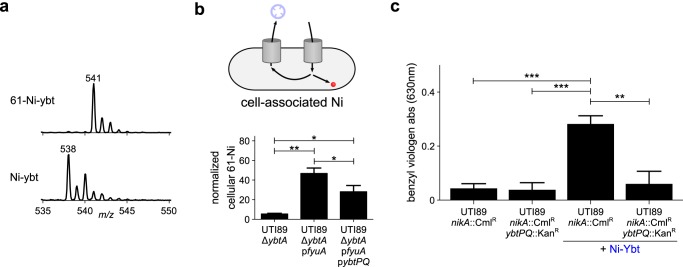Figure 3.
Ybt-derived nickel is retained and supports [NiFe]-hydrogenase activity in uropathogenic E. coli. To determine the fate of the nickel ions, the uptake experiment shown in Fig. 2 was repeated with isotopically labeled 61Ni–Ybt. a, the purity of 61Ni–Ybt was assessed by LC-MS as compared with Ni–Ybt. b, the cellular nickel content was measured by ICP-MS. 61Ni content was normalized to the content of the naturally abundant 60Ni isotope. The cartoon indicates which component of the uptake pathway was monitored. c, UTI89nikA::CmlR and UTI89nikA::CmlRybtPQ::KanR cells were grown in oxygen-limited conditions with or without addition of exogenous Ni–Ybt. The [NiFe]-hydrogenase reduction activity of the cells was observed upon addition of benzyl viologen to the cultures. The [NiFe]-hydrogenase activity was quantified by measuring the increase in absorbance at 630 nm after 10 min. The experiment was performed in triplicate, results are shown as mean ± S.D. *, p < 0.05; **, p ≤ 0.01; ***, p ≤ 0.001 based on a t test (two-tailed). Unmarked comparisons are nonsignificant.

